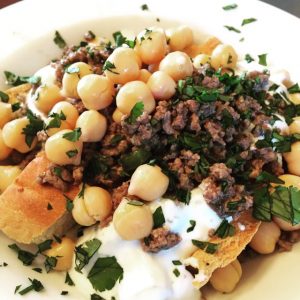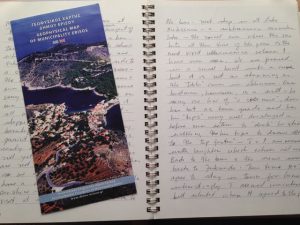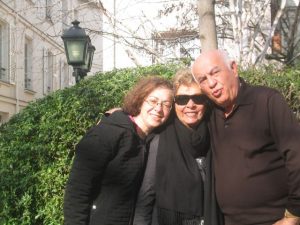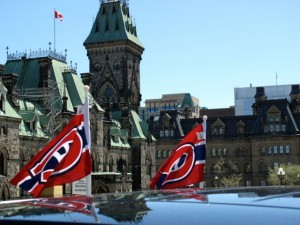Posts Tagged ‘memories’
Remembering Uncle P. – A Tribute
I don’t know how to do it.
I don’t know how to understand a world that no longer has Uncle Pethro in it.
It’s not that I’m overwhelmed with grief at his passing. Losing my mother eight years ago shifted my perspective on death and dying. So, I am sad, I am heartbroken, I am bereft, but I am not in pieces.
Still, the journey of saying a final goodbye to someone who has been a constant fixture in my life is difficult. Coming to terms with the impact his loss has on others is even more fraught with emotions.
The formal obituary tells the story of Uncle Pethro’s life and outlines the legacies of his accomplishments, achievements, and successes. It pays tribute to his extended and extensive family and honours the woman who stood by his side over six decades, matching him stride for stride over the years, my Aunt Madge.
But who was this man to me?
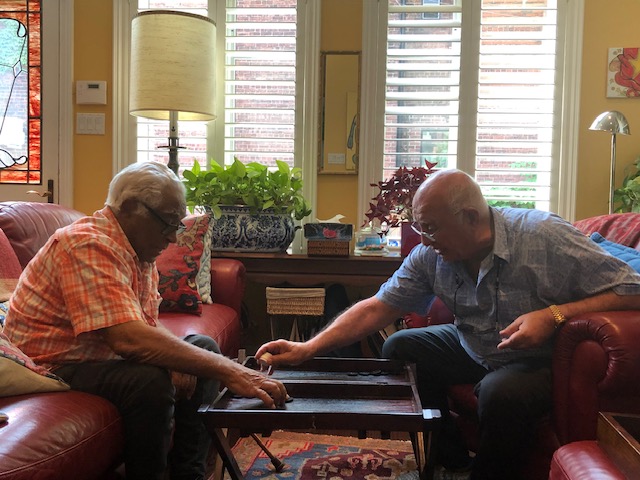
My mother’s first cousin and one of her best friends. Uncle Pethro and my mom shared a bond that helped each of them triumph over the reality of being outsiders. Others consigned them to the margins. They asserted their right to be at and in the centre. They made sure they were seen, heard, and recognized without compromising what they stood for and who they wanted to be. They did not accept the spaces others relegated them to and forged their own paths, carved out more imaginative lives, lived bigger stories than the ones others wrote for them.
Uncle Pethro was the man who would say, “Let me look at you!” even if you were standing right in front of him. He didn’t just want to see the face you presented to the world, he wanted to see the essence of who you were on the inside.
He was also the man with the all-consuming embrace. The man whose arms would wrap around you and make you feel protected, invincible, and treasured.
He was the man whose voice echoed in the room, whose voice was deep, resonant, and full. And — I say this with love — it’s a voice you heard often and at length because he loved to pontificate! He wanted to dig out the complexities of life, to talk about its nuances, to sort out its chaotic randomness at the same time that he could be rude, crude, and indelicate.
He was the man who had a pride of place. He loved Jamaica, the land of his birth, in all its contradictions, even if it was the home he had to leave to find the space to be free and to become the man he wanted to be.
He was generous, caring, and thoughtful, opening his doors, at home and at work, to a diversity of folk. He and Aunt Madge entertained well and often, and they set a standard as hosts that is difficult to achieve, and essential to emulate.
We all forgave Uncle Pethro his bombastic nature because underneath it all beat a passionate, life-full, and cheery heart.
Until it didn’t.
Ultimately, it was Uncle Pethro’s body that stopped working with him and started to work against him, that whittled away at him.
He was stalwart throughout each health crisis that battered him. His physical strength and mental toughness, along with Aunt Madge’s love, diligence, and care, carried him further and for longer than seemed possible.
When I moved to Toronto in 1986, Uncle Pethro and Aunt Madge welcomed me into their home and made sure I never felt alone in the vastness of the city or lost in the gulf of the choice I had made when I left home.
They saw me through the ups and downs of my time in that city, celebrated with me when things went well and consoled me when they did not. We shared food, drink, and conversation. We built a bond that transcended the familial connection. That feeling of being a part of each other’s lives became even stronger after I returned to Vancouver and our visits, because of the distance, became occasional rather than frequent.
Having spent the last few days in Toronto with Aunt Madge and the family, I’ve been reflecting on the past and ruminating on the future. Now I’m sitting here in seat 2B on Porter Air, Flight 309, surrounded by strangers, high above the clouds, and anxious to get home. I’m trying to make the pictures in my mind, of the vibrant, vital person I knew and loved, more animated and I’m fighting the way I feel that they are blurring and ebbing already. I’m trying to understand this new world that has lost that singular gravelly voice, that strong embrace, that hearty appetite, that appreciation for beauty, and that gift of laughter.
It’s not about making a saint out of my Uncle Pethro or remembering him as a paragon of virtue. It’s about knowing to love him as the man that he was.
Because if there’s anything I’ve learned from the years of being in Uncle Pethro’s company, is that to be human is divine even if we are flawed and our lives are finite.
To understand this world without Uncle Pethro is to understand that it was better with him in it, and that it will still be good because he was once a part of my mornings and my days, my nights, my years, my joys and my sorrows.
I will remember him.
Rest in peace Uncle Pethro.
Walk good.
An “Old Country” Family Favourite
Three days ago, I posted a photo of what I’d made for dinner on social media. It received likes, hearts, compliments, and requests for the recipe.
I’m pleased to share that recipe with you now albeit with hesitation.
Why?
Because I learned to cook from my mother and my grandmother and they didn’t use recipes!
And while I always use recipes for baking and sometimes for savoury dishes, my version of cooking is a little bit of this and a little bit of that and I wonder what this would taste like if I added that.
So take this more as a guideline for preparing Fateh al Laban (laban is the Arabic word for yogurt). Make the dish your own by experimenting with the proportions and the seasoning. There’s a vegetarian option, too, that Mom developed. I’ll describe that alternative after I’ve given you the details for preparing the traditional dish.
There are six components to Fateh: croutons, chickpeas, pine nuts, ground beef, yogurt, and herb garnish. I find it easiest to serve the components separately. Each diner can then assemble a plate according to their likes and dislikes. That also means the leftovers keep better than if they’ve been mixed together.
Croutons
Take two loaves of pita bread. Separate the halves of each loaf and tear them up into bite-sized pieces. Spread on a baking sheet covered with parchment paper and cook in a 350˚ oven until golden brown. Remove and set aside. Regular croutons will work but then you’ll miss out on the Lebanese look!
Chickpeas
Open a small can of chickpeas. Drain and rinse the chickpeas. Let them sit in a colander to dry until you’re ready to serve.
Pine Nuts
Fry a handful of pine nuts in butter until golden. Remove and set aside. Alternatively, mix them with a touch of olive oil and bake in a 350˚ oven until golden brown. Pine nuts burn easily, so check on them frequently if you have them in the oven. If you’re frying the pine nuts, turn off the heat just as the pine nuts begin to brown.
Ground Beef
I typically use .5 kilogram (1 pound) of lean or extra lean ground beef for two and that leaves a lot for leftovers. Fry the ground beef in a pan until cooked through. Season with salt, pepper, and allspice (no more than 15 ml, 1 teaspoon, of the latter). You can also add chopped jalapeño and a few drops of Worcestershire Sauce. Drain and keep at room temperature. As I’m writing this out, I realize that it would also work to mix the pine nuts in with the beef. I might try that next time.
Yogurt
Use approximately 250 ml (1 cup) of plain yogurt. It doesn’t matter which brand you choose or whether the yogurt is skim, 2%, or whole. I’d recommend the 2% or whole — just make sure it’s plain and not French Vanilla! In a mortar, crush 1/2-1 clove of garlic with salt, pepper, and a few, washed, shredded fresh mint leaves. Add the spiced garlic paste to the yogurt and mix thoroughly. You can also mix in diced cucumber to the yogurt mixture for an extra bite.
Garnish
Finely chop a green herb to use as garnish. I use cilantro because L. likes the flavour; parsley is the traditional option. You could also use mint or a combination of any or all three.
And that’s it. Seriously. Those are the components and once they’re ready to go, layer them in a bowl and dig in! I prefer to put the croutons on top rather than using them as a base so that they stay crunchy. If you place them under the yogurt, they get soggy pretty quickly.
Vegetarian Option
- Substitute boiled pasta — rotini or penne works best — for the croutons.
- Substitute broiled eggplant slices for the ground beef.
- Leave out the chickpeas.
- Mix all ingredients together to serve and garnish with chopped herbs.
Sahtain — bon appétit in Arabic — and let me know how your version of this dish works out.
For me, this dish is one of my comfort foods and L. loves it, too.
As with so many things, to share this dish with you is to share memories of Mom and to honour her legacy. Thanks for requesting the recipe.
A Life In Script
I feel the absence of my mother most keenly when I catch a glimpse of her writing.
When I look at the carefully crafted words and sentences she moulded; the ones she wrote down. An alchemy of thought, energy, effort, pen, and paper.
Mom used writing to express her thanks. To scold political leaders. To extend congratulations. To advocate for causes. To nurture connections.
She cherished the handwritten note even after her grandsons helped her learn to use email.
My mother believed there was a personal quality to a handwritten note that was impossible to replicate in type form. I agree. Each stroke of the pen captures a person’s personality, their character, history, and experience. The way in which hand-written words create a web of meaning is the most affirmative statement of “I am here”. When I catch sight of my mother’s writing script I wonder how it is that she is not here.
How can the person whose heart propelled the pen across the page not be here to cross that t and dot that i?
I feel the absence of my mother most keenly when I see her writing, with an intake of breath and a vise clamped around my heart.
My mother’s script is from an earlier era when education had not been commodified and contorted. When it was a gift to learn. A time when writing was valued not only for its content but for its form. When penmanship spoke of culture and education and, yes, privilege.
That script, her unique cursive style, is undeniably and uniquely my mother, Yulanda.
I feel the absence of my mother most profoundly when I stare at her writing.
René Descartes said, “I am thinking, therefore I am.” My mother’s cursive script says, “I wrote, therefore I have been.” And as the ability to recall her physical presence becomes the dream of time lapsed, her writing will remain forever real and tangible.
As her daughters, her children, and perhaps someday her grandchildren and descendants, we will carry her DNA forward in time. However, her letters, the drafts of her speeches, the thank-you cards, her recipes, the quotations she noted down, her signature — like the one in the volume of William Shakespeare’s collected works that she used for her studies at McGill — these all serve as a testament to her personal spirit.
No other hand shaped those words, no other mind developed those ideas, no one else forged those connections: letter to letter, person to person, heart to heart.
I feel the absence of my mother most keenly when I catch a glimpse of her writing. The words and sentences that flowed from the pen she held, the pen she guided into forever.
In the year and months since my mother died (and a month before what would have been her 79th birthday), my family has cried, laughed, and celebrated birthdays, anniversaries, graduations, and weddings. We’ve attended funerals. We’ve had time at home, we’ve been away together and separately. Time has carried us forward. It is life’s imperative.
And she, my mother, has been there with us. In each moment, in each thought, in each word.
She always will be.
“If we danced more and sang more, we’d be happier people.”
Yulanda M. Faris
July 2, 1937 – April 23, 2015
A Man For All Seasons
Author’s Note: I’m sad to report that FUB passed away on May 27, 2014. The world is a dimmer, duller place without him.
There is a man I know.
His name is Robert.
Bob.
Or as we like to call him FUB – Funny Uncle Bob.
Funny because he is witty and bright. Even in a serious discussion with Bob, there will come a point when you find yourself laughing. Maybe a chuckle, but more often than not a belly laugh, a laugh from the heart.
Bright because he is a spark. He creates, he paints, he draws, he writes. He is an artist, an inspiration, a giver, a friend, a husband, a father, a grandfather.
He’s not actually my uncle, but the dearest and closest of family friends. If I were to ask my parents, I’m sure they would recall the moment when they first met Bob and his wife Carol. For me, and I think for my sisters, it’s as if Bob has always been there. There is no first moment, there just is.
In 2010 my parents received the Ramon John Hnatyshyn Award for Voluntarism in the Performing Arts. Each recipient of a Governor General’s Performing Arts Awards is allotted a number of tickets to the events held for honourees. The number in our group exceeded the limit because my father lobbied to ensure he could include Bob and Carol.
Our four days in Ottawa were magical. From evenings in the bar, to Question Period in the House, to receptions and galas, Bob’s wry gaze, Bob’s singular perspective, Bob’s irreverence enhanced and enlivened every moment.
Bob’s generosity of spirit has spilled over into his interactions with my son who is an emerging artist. During a visit to Hornby Island in 2008, we went on walks together and we would sketch en plein air to capture the golden aura of Helliwell Park and the shimmering blue of the ocean. I was even required to join in and put pencil to paper!
Bob also sat down with my son indoors and they drew together in the creative stillness of common purpose. It was mentorship of a seven year-old to show what it means to observe as an artist, to be diligently aware of your surroundings, and how to express what you’ve seen for others to experience.
This past summer, my mother, my son, and I went out to visit Bob and Carol at their home. It was an opportunity for my son to see Bob’s studio, to have a look at Bob’s world, the world of a successful artist. My son was whisked away upon arrival and when the two rejoined us for lunch, my son was clutching canvases, drawing paper, and pens. Gifts from one artist to another with the most priceless one being the encouragement to do.
That’s FUB.
That’s Bob and he has decided to discontinue chemotherapy. He is at home with his family and he is embraced within a circle of love which extends beyond the boundaries of time and place.
His name is Robert.
There is a man I know.
And thus it shall be forever.
Getting to Know Me and You
In a recent blog post, Chris Kennedy, Superintendent of Schools for West Vancouver, issued a challenge which involves providing 11 random facts about one’s self, answering 11 questions, and posing 11 questions for others to answer.
I don’t have an athlete’s competitive gene in the way Chris does, but I’m not one to pass up a challenge — particularly one which offers an easy way into kickstarting my blog for the year.
So here goes:
11 Facts About Me
- I’m the eldest child in my family and I use birth order psychology to rationalize my tendency to be bossy.
- Athletic competition is not my forte, but I was a competitive swimmer when I was younger.
- And while I may not be an athlete, my competitive instincts do tend to arise if faced with a New York Times crossword puzzle, a game of Trivial Pursuit, or any sort of game involving my five nephews.
- I was one of the original hosting staff hired for Expo 86 in Vancouver. I worked in the pre-fair period, first at the display pavilion conducting tours of the site model, and later at the Expo Centre which eventually became Science World.
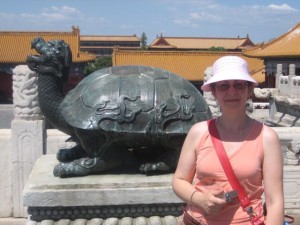
- Although I did have that experience with Expo, I resigned my position before the Fair actually opened – not one of the best decisions I’ve ever made.
- I lived in Toronto from 1986 to 1992 and worked for a variety of companies including Addison Wesley Publishers, Canada Mortgage and Housing Corporation, and Rogers Cablesystems. I also obtained my MBA from the University of Toronto while there.
- During my time in Toronto, I took creative writing lessons through the Continuing Education department at the U of T. My instructor, for two terms, was Anne Michaels who subsequently found much acclaim with the publication of her novel Fugitive Pieces among other works.
- I still have the letter Ms. Michaels wrote to me at the end of one term (she wrote a letter for to each student) encouraging me to give myself the gift of time to write. I have to admit, I’ve never quite learned how to do so, but I still may.
- While working for CMHC, I was seconded to the G8 1988 Economic Summit and worked in the media centre. I think I may have caught a glimpse of Margaret Thatcher once from a very great distance!
- My return to Vancouver in 1992 was prompted by a number of factors, primarily the impending birth of my first nephew. That’s one of the best decisions I’ve ever made because it brought me back home and allowed me to play a bigger part in his life, and the lives of his brothers, than I may have been able to from far away.
- September 2014 will mark 40 years since my family moved to British Columbia and settled in West Vancouver.
Questions from Chris Kennedy:
- If you could only watch one television station what would it be? CBC Newsworld
- Looking back at your schooling, what was the silliest rule your school had? I don’t remember which is probably a clear indication that school rules aren’t as effective as we’d like them to be. Or it may only be evidence of my memory issues!
- Who is the greatest ever Canuck? I’m sure I’d answer this differently every day and we’re lucky to have so many choices. Today I’m going to pick Lester B. Pearson because I believe he was a man who had a vision of how Canada could operate on the world stage in a manner which promoted peace and reconciliation. Our political leadership now seems to have abdicated that position. [Editor’s Note: I realize now Chris meant the hockey team and not Canadians in general in which case I’ll say Trevor Linden although I was also a Harold Snepsts fan. Oh, and Kirk McLean.]
- What is the greatest rock group of the 1980s? Please see the note above re memory issues. I was a Fleetwood Mac enthusiast and also a fan of the Little River Band, but I think that may have been more reflective of the 1970s.
- What is something education related you have changed your opinion on over your career? Assessment although not necessarily academic honours and awards.
- What is the warmest place you have ever been — and how warm was it? China in July 2009. My eyeglasses would fog up as soon as a I stepped out of the hotel lobby and I remember being drenched in perspiration from morning to evening.
- Poorest fashion trend you have seen in schools in the last 10 years? Ugh to Uggs.
- What was more frustrating to deal with in your school — Pokemon cards or silly bands? Luckily my role precluded the need to deal with this issue.
- Describe your favourite high school teacher in four words. Miss Lysell: dramatist extraordinaire inspiring imaginations.
- What is the best reason to go on Facebook at least once a day? For a smile while refreshing connections with friends and family, near and far.
- If blogging was outlawed tomorrow — what would be your reaction? Phew!
11 Random Questions for You:
- When you think back to your time as an elementary and/or high school student, what’s the one thing you wish had been done differently?
- What’s your favourite movie and why?
- If you were asked for one piece of advice to offer a first year student at a post-secondary institution, what would it be?
- What was your favourite song of 2013 and why?
- Who would you say serves as the best role model for young people today?
- Think about the work you’re doing now. Is it part of a career you had planned on or are you doing something you had never thought of doing when you were younger?
- If you could pitch an idea for a television show, what would it be? (Credit for this question goes to my son!)
- On a sunny day, do you make every effort to get outside or do you sometimes prefer to stay at home?
- If you had to choose one animal to best describe who you are, what would it be? (I was once asked this question in a job interview!)
- What do you think is one thing we could do to encourage more young people to vote in municipal, provincial, and federal elections?
- What is one change you hope to make in 2014?
I Challenge the Following People to do their “Homework”:
As Chris did, I extend the challenge of this activity to the educational community in the West Vancouver School District including parents and students who write and maintain blogs. I’d also like to extend the challenge to Trustees throughout British Columbia. It’s an interesting way to allow our communities to get to know us just that little bit better beyond our role as advocates for the public education system.
